Dangun › Darius I › The Monastic Movement: Origins & Purposes » Origins and History
Articles and Definitions › Contents
- Dangun › Origins
- Darius I › Who Was
- The Monastic Movement: Origins & Purposes › Origins
Ancient civilizations › Historical places, and their characters
Dangun › Origins
Definition and Origins
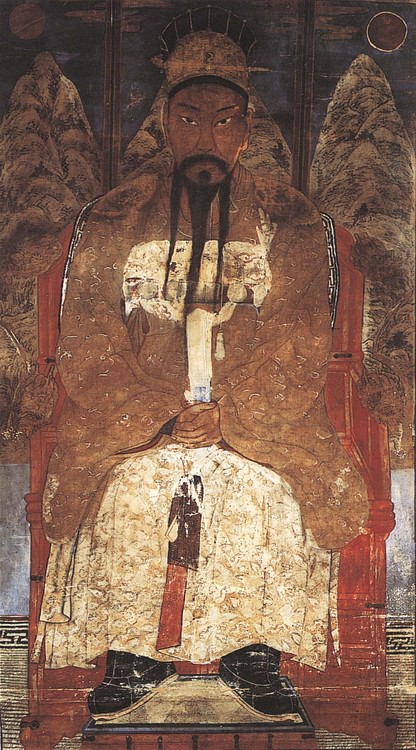
Dangun Wanggeom (or Tangun) was the legendary founder of Gojoseon (Gochoson or Old Choson), the first Korean state which ruled northern Korea in the second half of the first millennium BCE. Gojoseon possessed the most advanced culture in the Korean peninsula at that time and was an important marker in the progression towards the more centralised states of later periods. According to mythology, Dangun was born on the third day of the tenth month and so the 3rd of October is celebrated as National Foundation Day in modern South Korea.
HWANUNG & UNGNYO
According to Korean mythology, as recounted in the 13th-century CE Samguk yusa ('Memorabilia of the Three Kingdoms'), Hwanung, the son of Hwanin, the supreme deity, asked his father if he might be allowed to descend to earth and live there instead of heaven. Hwanin consented and, giving Hwanung three seals of authority, selected Mt. Taebeck (near Pyongyang ) as the best place for his son to arrive and settle. With the god came 3,000 followers, including the Earl of Wind ( pungbaek ), Master of Rain ( ubaek ), and Master of Clouds ( unsa ). Hwanung built a town called Asadal on the slopes beneath a sandalwood tree, hence his other name of 'Lord of the Pakdal tree' or Sandalwood Prince. From the mountain, the god dispensed to his followers such quintessential elements of life as culture, agriculture, good and evil, punishments, illness, and lifespans.
One day both a bear and a tiger came to Hwanung's residence in prayer and asked to be transformed into humans. The god agreed to this gift but on the condition that they remain out of the sun for 100 days and eat only a sacred bunch of mugworts and 20 garlic cloves. To this the animals agreed and followed his advice. The tiger was unable to keep up with the conditions, but the bear – a female called Ungnyo – after only 21 days was transformed into a woman. She longed for a child and so, shortly after the god married her, Dangun was born.
THE MYTH OF DANGUN MAY SYMBOLISE THE ARRIVAL OF BRONZE AGE CULTURE IN KOREA WHEN THE METAL WAS BROUGHT FROM MANCHURIA DURING THE SECOND MILLENNIUM BCE.
The myth of Dangun's birth may symbolise the arrival of Bronze Age culture in Korea when the metal was brought from Manchuria during the second millennium BCE. The inclusion of a bear in the myth may reference the shamanistic beliefs and animal totems of the nomadic tribes who migrated from the Asian interior in this period and settled in the Korean peninsula.The tiger, on the other hand, was often a subject of Korean folk art and so, perhaps, represents the Korean people. Indeed, in this sense, Dangun may be considered the first Great Shaman who provided a link between the spirit and animal world with humanity. The ruler's divinity was also, no doubt, a useful political tool for later kings to claim, via their direct descent, a divine right of rule.
DANGUN & KIJA
Dangun is traditionally credited with then creating the entire Korean race and ruling over the kingdom of Gojoseon, ancient Korea's first proper state, which was founded in 2333 BCE. Indeed, Dangun's name means 'mountain-birch ruler' or 'altar ruler' and Choson is sometimes referred to as Dangun Gojoseon/Tangun Choson. Needless to say, there is no archaeological evidence for a unified state at this time and historians agree that the historical Gojoseon only existed from the 7th century BCE at the earliest and may never have achieved a fully centralised control of the region.
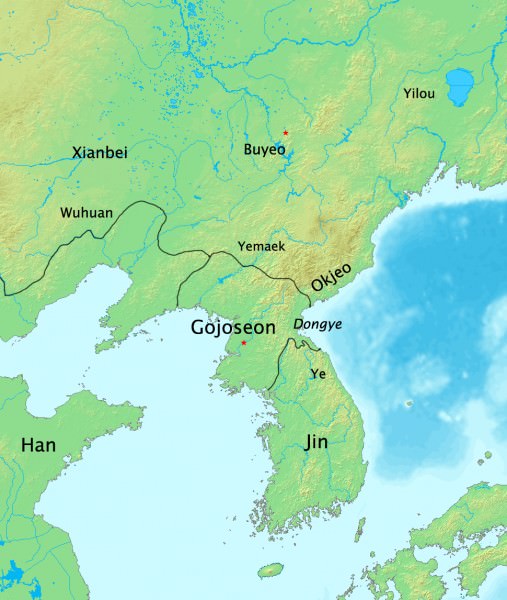
Map of Korean States in 108 BCE
Returning to our myth, after Dangun had ruled for over 1,000 years he decided to become a spirit and live in contemplation at the Heavenly Lake on Mt. Paektu. Dangun's role as king of Gojoseon was taken over by the sage Kija (Jizi in Chinese), who had left the Chou dynasty of China with 5,000 followers and settled in Dangun's kingdom. This happened in 1122 BCE, and the legend may represent the arrival of Iron Age culture to Korea and symbolise early relations between China and Korea, especially the passing on of Chinese methods of administration and government which Dangun is credited with introducing in Gojoseon. It is, perhaps, significant that the myth of Dangun's birth takes place during the reign of the (also mythical) Chinese emperor Yao.
LATER LEGACY
The Dangun legend has cropped up several times over the centuries and continues to be a powerful myth even today. During the Goryeo dynasty (or Kuryo dynasty, 918-1392 CE) Pyongyang was selected as the capital with one of the reasons being that it was the traditional first capital of Dangun and the Korean people. In the art of the Joseon Dynasty (1392-1910 CE) the Shaman Mountain god Sansin (and later Buddhist bodhisattva) is frequently portrayed in the guise of Dangun wearing a crown. During the Japanese occupation of Korea Dangun was worshipped as a potential returning saviour of the nation by the Taejong-gyo sect. During the Empire period (1895-1910 CE) and again in the Republic of Korea from 1948 to 1961 CE the calendar counted from the Dangun founding date of 2333 BCE. In modern South Korea the 3rd of October, Dangun's birthday, is celebrated as National Foundation Day ( Kaechonjol ). Finally, evidence that the myth still carries a political resonance is seen in North Korea's claim (unsupported by scholars worldwide) to have actually discovered the tomb of this legendary figure near Pyongyang in 1993 CE and thus considers itself the true home and inheritor of Korea's first cultural hero.
This article was made possible with generous support from the British Korean Society.
Darius I › Who Was
Definition and Origins
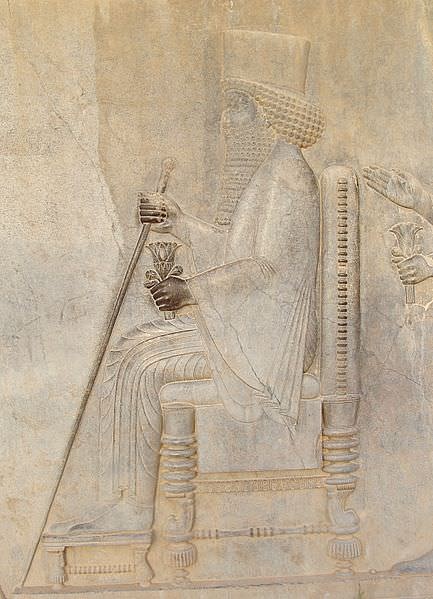
Darius I (c. 550-486 BCE), also known as Darius the Great, was the third Persian King of the Achaemenid Empire. His reign lasted 36 years, from c. 522 to 486 BCE; during this time the Persian Empire reached its peak. Darius led military campaigns in Europe, Greece, and even in the Indus valley, conquering lands and expanding his empire. Not only resuming to military prowess, Darius also improved the legal and economic system and conducted impressive construction projects across the Persian Empire.
RISE TO POWER
The most important primary sources, that tell us about his life and reign, are his inscriptions, the most famous example being the trilingual inscription, in Akkadian or Babylonian, Elamite, and old Persian, carved on the Bisitun (Behistun) rock relief from the village of the same name and from his palace at Persepolis. Also, accounts about his reign were chronicled by the Greekhistorian Herodotus.
Darius was born in c. 550 BCE, the oldest son of Hystapes and Rhodugune. The Behistun inscription mentions that his father occupied the position of satrap (regional leader) of Bactria and Persis during the reign of Cyrus the Great (559-530 BCE) and his son, Cambyses (530-522 BCE). During the reign of Cambyses, Darius held the position of spearman ( doryphoros ) and accompanied the king in his campaign to Egypt between 528 and 525 BCE. Before leaving for Egypt, Cambyses named Patizithes as custodian of the royal palace in his absence. Patizithes saw this situation as an opportunity to gain power. He set up his own brother, Gaumata, as a false king under the name of Bardiya or Smerdis, Cambyses' brother, becoming the new ruler in 522 BCE. Cambyses II returned to his country seven months later only to find that he could not take his throne back.Some historical sources say he took his own life as he was unable to defeat the impostor king and his supporters, while other tell us he fell during the marches through Syrian Ecbatana or through Damascus.
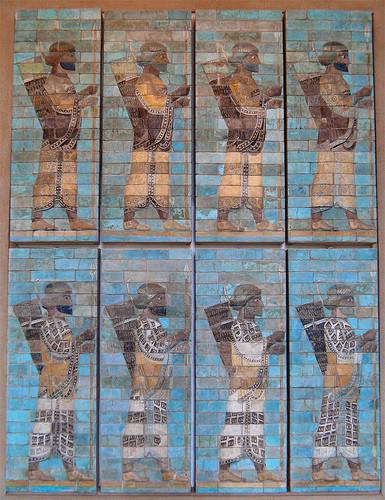
Ranks of Immortals
The false king's reign did not last long. Herodotus tells us that Phaedymia, the daughter of Cambyses' uncle, Otanes, found out that the ruler is not Cambyses' brother. Her father, after learning the truth, quickly assembled a group of conspirators which included Hydarnes, Intaphrenes, Megabyzus, and Darius, who at the time was still the king's lancer. Gaumata was finally assassinated, leaving the Persian empire without a leader; the conspirators had to decide the future of the empire. Otanes opted out, wanting only special privileges for his family, oligarchy was suggested by Megabyzus, while Darius voted for a monarchy. Being unable to settle the matter at hand, all of them agreed on a contest, where the winner would take the throne.All of them would meet the next morning, each on his horse, and the first horse to neigh at the sunrise would be named the new king. Herodotus tells us that Darius cheated; supposedly it was his servant, Oebares, who made the horse neigh by letting the animal smell his hand that he had previously rubbed over the genitals of a mare. In any case, the horse's neigh accompanied by lightning and thunder from a storm convinced the others to accept Darius as the new king in 522 BCE.
Even though Gaumata was a false ruler, only a portion of satrapies recognised Darius as their king, after his coronation, in 522 BCE, such as Bactria and Arachosia. Others saw the false king's death as a chance for independence. Revolts broke out across many regions of the empire, including Persis, Media, Parthia, Assyria, Babylon, and Egypt, and only with aid of his army and personal entourage did Darius manage to quell these conflicts. These events are chronicled in great detail in his inscriptions, translated by Herbert Cushing, which also serve as a warning for future kings:
Says Darius the king: O thou who shalt be king in
the future, protect thyself strongly from Deceit;
whatever man shall be a deceiver, him who deserves
to be punished, punish, if thus thou shalt think " may
my country be secure." (30)[...]
Says Darius the king: O thou who shalt be
king in the future, whatever man shall be a deceiver
or a wrong-doer (be) not a friend to these; punish
(them) with severe punishment. (33)
MILITARY CAMPAIGNS
Darius' rule was marked by vast military expeditions. After consolidating his power at home, he set off to secure the lands of Egypt, which had been conquered before by Cambyses, and in 519 BCE he incorporated a large part of Egypt into his empire.The following year, in 518 BCE, he conquered parts of India, namely northern Punjab as his inscriptions testify. Herodotus adds that India was the 20th satrap of the empire and also that parts of the Indus valley were also conquered.
The next significant campaign was in European Scythia in 513 BCE. Historians have proposed several theories in an attempt to clarify the objective of this campaign. They range from simple military conquest to a more propagandistic motive, revenge for a previous conflict during the reign of Cyrus where the Scythians had attacked Medes. Another possible reason is that Darius wanted to conquer the western Greek lands and the Scythian campaign was supposed to threaten the Greeks into surrender.

Achaemenid Empire Map
However, Darius faced unforeseen difficulties. The Scythians evaded the Persian army, using feints and retreating eastwards, all the while laying waste to the countryside. The king's army chased the enemy deep into Scythian lands, where he sent word to their ruler, urging Idanthyrsus to fight or surrender. As Idanthyrsus refused to do either, the chase resumed. In the end, the campaign halted after a few weeks when sickness and deprivation had taken its toll on the Persian army. The march halted around the banks of the Volga river and then headed towards Thrace, where Darius ordered his general Megabyzus to subjugate the region.
Besides bringing Thrace under Persian influence, Megabyzus also conquered the neighbouring Greek cities. He sent envoys to Macedonia where Amyntas, the king of Macedonia, became a vassal of the empire. Meanwhile, Darius solidified his hold in Ionia and the Aegean Islands through appointments of Greek natives as city rulers or tyrants.
GRECO- PERSIAN WARS
In 499 BCE, Aristagoras, the tyrant of Miletus, convinced the satrap Artaphernes to sponsor a campaign against Naxos.Darius gave his consent and named Megabates, Artaphemes's cousin, as commander of the Persian army. They were supposed to be supported and supplied by Aristagoras, but a quarrel between Megabates and Aristagoras resulted in the former betraying them and informing the Naxians of their plans, sabotaging the campaign. Finding himself without help, Aristagoras decided to revolt against the Persians. Seeking other allies, although he failed to acquire the support of Sparta, he managed to secure the aid of Athens and Eretria, both providing troops and ships.
After six years of conflict, during which Sardis, Cyprus, and the Hellespont were attacked, the Persian army defeated the rebels at the Battle of Lade in 494 BCE where most of the Athenian fleet was destroyed. Undeterred, Darius gathered his army, planning to conquer Athens. His army consisted of infantry and cavalry, led by the general Datis. They marched from Susa to Cilicia, where ships carried them across the Aegean Sea to the island of Samos. Here they joined up with an armed force from Ionia and sailed north, to Athens.
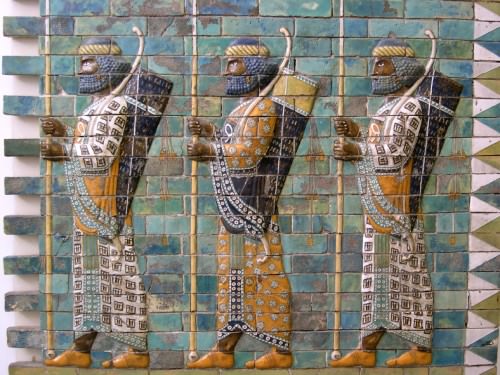
Persian Archers
Meanwhile, the Athenians started to prepare for war. Envoys were sent to Sparta, but after gathering allies, the Greek force was still only 10,000 strong, facing 100,000 Persians. Outnumbered, the Greek generals needed a brilliant strategy. Two of them advised facing the enemy from within the safety of the city gates, but Miltiades convinced them that a direct attack would be a better choice. They agreed, on condition that Miltiades would lead the army into the battle.
The two opposing armies met on the fields of Marathon in 490 BCE. The Persian army, though heavily outnumbering the Greek army, was slow and overconfident. The Greeks took advantage of this situation; as the two armies approached each other at a casual pace, the Greeks suddenly broke into a sprint. This caught the Persians off guard, and before they knew it they were forced to battle in full hand-to-hand combat. After a few hours of battle, the Persian ranks broke, many of them running towards the safety of the ships or to the nearby mountains. 6,000 Persians fell, while the Greek army lost only 200 men. The marble blocks which the Persians intended to use for the monument they were going to erect after the battle, was instead used by the victorious Greeks to build a monument for their fallen comrades. This blow was seen as an insult by Darius, who chose to fight on and prepared for another invasion. This plan, however, never came to fruition due to his death in 486 BCE.
GOVERNMENT
The Persian Empire witnessed many improvements during Darius' reign. He established 20 provinces or satrapies, with an archon or satrap assigned to each. Neighbouring regions paid a fixed tribute; a fair amount was stipulated by a commission of Darius' trusted officials.
DARIUS ATTRIBUTED HIS SUCCESS TO AHURA MAZDA & ALL OF HIS LAWS WERE CREATED IN THE NAME OF THE ZOROASTRIAN GOD.
He also improved the legal system, using the Babylonian Hammurabi as a model and copying some of his laws completely.The laws were enforced by the judges of the empire, who needed to be incorruptible. Darius removed the previous native officials, replacing them with new people loyal to him. While the punishments may seem brutal today, ranging from mutilation to blinding, fairness was not omitted as punishment depended on the nature and severity of the crime. The new system proved to be popular, even after Darius's death, some laws were still in use in 218 BCE.
In the matters of religion, it is well known that Darius was an adherent of Zoroastrianism or at least a firm believer of Ahura Mazda. This we can see in his inscriptions, where he attributes his success to Ahura Mazda, and in his legal system where all laws were created in the name of the Zoroastrian god. In the lands that were under Persian control, all other religions were tolerated as long as they remained submissive and peaceful.
ECONOMY & BUILDING PROJECTS
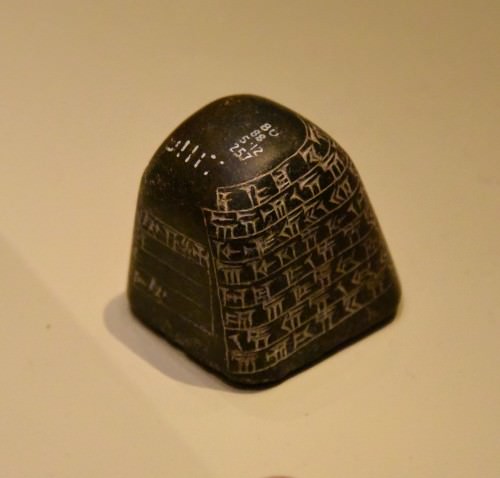
Darius I Inscribed Stone Weight
Darius introduced a new universal currency, the darayaka, sometime before 500 BCE. This innovation made it easier to collect taxes on land, livestock, and marketplaces, which led to improved revenues for the empire. To further improve the economy and help traders, a new standardised system of weights and measures was introduced.
DEATH & LEGACY
After the defeat at Marathon, Darius did not want to give up on his dream to conquer Greece. He vowed to gather an even larger army, this time leading it personally, to fight the Greeks. After three years of preparing, during which he became ill, a revolt broke out in Egypt that only worsened his condition. Darius died in October 486 BCE; his body was interred at Naqsh-e Rustam in a tomb prepared by him beforehand, a custom of Persian kings. After his death, the throne was inherited by his eldest son from his marriage with Atossa, Xerxes.
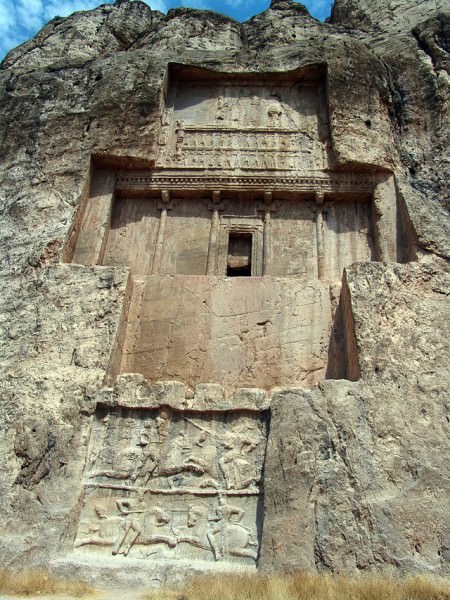
Tomb of Darius I, Naqsh-e Rustem
Darius's reign was one of the most important episodes in the history of the Persian Empire. His military conquest expanded the boundaries of Persia, and internally, his reforms improved the vitality of the empire. Some of his improvements have survived even to this day such as his laws as the basis for the current Iranian law.
The Monastic Movement: Origins & Purposes › Origins
Ancient Civilizations
In 313 CE, Constantine the Great (272 – 337 CE) ended the sporadic-yet-terrifying Christian persecutions under the Roman Empire with his “Edict of Milan,” and brought the Christian church under imperial protection. Not surprisingly, public social activities and normative culture changed, quite dramatically and favorably, for the early Christians. Previously, early Christians faced dangers from outside of the faith and often had to “worship underground,” in order to avoid both physical dangers and social oppression from various Pagan and Jewish factions in the first three centuries of the faith. However, after Constantine’s imperial endorsement and favoritism for Christian leaders and the laity, a new cultural permissiveness and secularism arose within the faith; and pious believers began to worry more about inner church immorality, abuse, and vice.

Saint Anthony
BEGINNING OF THE MONASTIC MOVEMENT
Gonzalez writes, “The new privileges, prestige and power now granted to church leaders soon led to acts of arrogance and even to corruption” (143). As such, many in the primative Jesus movement sought a different, less secular, more purist environment in which to pursue their spirituality. MacCulloch states, “It was hardly surprising that the sudden sequence of great power and great disappointment for the imperial Church in the West inspired Western Christians to imitate the monastic life of the Eastern Church” (312). Thus began the official monastic movement in the West.
THEY WERE NOT PART-TIME CHRISTIANS. THEIR ALL-OR-NOTHING ATTITUDES LED THEM TO RENOUNCE ALL CREATURE COMFORTS TO DEVOTE THEMSELVES TO SPIRITUAL WORK.
This Christian monastic lifestyle was simple at first, but, as is common to all societies, its routine became more and more convoluted and variegated with each passing century. One could find monks and nuns in caves, in the swamp, in a cemetery, even 12 metres (40 feet) up on stylite - all proclaiming God's calling and affirmation of their personal lifestyles. Eventually, specific rules and over-arching regulations were developed by the church institution to align all the numerous, specific groups into healthier, more consistant expressions of Christianity in the monastic movement.
The origin of the monastic movement begins in the 3rd and 4th centuries, CE, in the deserts surrounding Israel. As Nystrom notes,
Scholars have searched widely for the antecedents of Christian monasticism, hoping to find its pre-Christian roots in such possible points of origin as the Jewish Essene community at Qumran near the Dead Sea and among the recluses associated with the temples of the Egyptian god Sarapis. Thus far, no clear links have ben established to these or any other groups (74).
THE MONASTIC LIFE
Although little direct evidence exists amid a plethora of colorful and inconsistent stories, these dedicated ascetics were known, historically by their special approaches to the Christian faith and by their local community approval. They were not part-time Christians. Their all-or-nothing attitudes, disenchantment with society, and desire to effectively influence the world (without being of the world) led them to renounce all creature comforts in order to utterly devote themselves to spiritual work such as praying, social services for the community, teaching, and spreading the Christian faith. Additionally, this was not a singular gender affair; many female monastic communities were also established throughout the centuries. Thus, many female believers were empowered in the monastic movement to exercise and utilize their personal gifts, becoming nuns, hermitesses, Beguines, Tertiaries, or anchoresses - a unique feature in that patriarchal age.
EARLY MONASTIC LEADERS
Several early monastic leaders or models are discussed and detailed in the early church fathers' (and mothers') writings. Saint Anthony of the Desert (c. 251 – 356 CE) was said to be an Egyptian holy man who initially lived as a hermit “... in the desert lands along the Nile ” (Nystrom, 74), but later “He came out of his solitude to organize his disciples into a community of hermits living under a rule, though with much less common life than the later religious orders had” (Livingstone, 29).

Amma Syncletica of Alexandria
Another Desert Mother, Amma Syncletica of Alexandria (c. 270 – c. 350 CE), dedicated her life to God after the death of her parents and,
... gave all that had been left her to the poor. With her younger sister Syncletica abandoned the life of the cityand chose to reside in a crypt adopting the life of a hermit. Her holy life soon gained the attention of locals and gradually many women came to live as her disciples in Christ ( The Desert Fathers, online).
An important and influential member of the monastic movement, her writings were also included with those of the Desert Fathers.
Others soon followed such as Saint Pachomius (ca. 290 – 346 CE) who helped establish cenobitic monasticism and established a monastery at Tabennisi, ironically on an Island of the Nile in Upper Egypt. One of the first to be called "Abba" (where the word "Abbot" comes from), he originally was pressed into the Roman army and was influenced by the Christians that he met in his work in Egypt. As Gonzales states, “Although not its founder, Pachomius deserves credit as the organizer who most contributed to the development of cenobitic monasticism” (165).
THE SPREAD OF MONASTICISM
In the 4th century CE, the monastic movement spread to the European continent when John Cassian (c. 360 – c. 430 CE), a “Desert Father” and friend of Saint John Chrysostom the “Golden-Mouthed” (c. 347 – 407 CE), founded this Egyptian-style monastery in Gaul (modern-day France). Cassian is somewhat controversial because of his mentors and allegorical position on the Christian scriptures, and for his mystical embrace of the three ways: Purgatio, Illuminatio, and Unitio. Nonetheless, Livingstone remarks, “His Institutes sets out the ordinary rules for the monastic life and discusses the chief hindrances to a monk's perfection; it was taken as the basis of many W[estern] rules” (101).
One of the most famous monastics (if not the most famous) was Saint Benedict of Nursia (c. 480 – c. 543 CE). MacColloch writes, “Benedict is a shadowy figure who quickly attracted a good deal of legend, lovingly collected into a life by Pope Gregory I [c. 540 – 604 CE] at the end of the sixth century” (317). He is credited with creating a monastic rule of order (although most scholars believe that Benedict borrowed some or much of it from “The Rule of the Master” or “Regula Magistri”) that was instituted and promoted as the standard for all of monasticism.

Saint Benedict of Nursia
Yet, Benedict says of his new orders that it was “a little rule for beginners” and required “nothing harsh, nothing burdensome” of the monks. Compared to other rules (such as the Augustinian model), it was relatively flexible. His rule required monastic vows of stability (a lifelong commitment and permanence), fidelity (one's character can be shaped), obedience (one is submissive to superiors), poverty (one gives up all wealth entering into the community) and chastity (one forsakes all carnal knowledge and pleasure). Monasteries under this order placed high emphasis on the spiritual benefits of laboring, prayer, and a consistent schedule.
LATER MONASTICISM
In later medieval Christianity, Cluniac monasticism (c. 909 CE) accentuated simplicity of lifestyle, but even more so focused on prayer and mystic contemplation; and Cistercian monasticism (c. 1098 CE) developed when the emphasis shifted away from menial labor to religious duties. Eventually, Saint Francis of Assisi (c. 1181 – 1260 CE) established a mendicant (begging) order that promoted poverty as the vehicle to ensure a holy lifestyle. Although also a mendicant order, the Dominicans (c. 1220 CE) focused on poverty and scholasticism and sought to bring heretics back to the church through debate and apologetics.
With such an ever-growing, diverse, complicated expression of Benedict's “Simple Rule for beginners,” the monastic movement has often been criticized for promoting stoicism, alienation, arrogance, superstition, and judgmentalism throughout the centuries. Shelley responds,
Naturally, these conflicting views of the place of monasticism in the church have led to conflicting interpretations of the history of the movement... The key question is, how does renunciation relate to the gospel? Is it a form of self-salvation? Is it works righteousness, an atonement for sin based upon denial of the self? Or is it a legitimate form of repentance, an essential preparation for joy in the good news of God's salvation? (117).
Ultimately, the ancient Christian men and women who joined these monastic groups sincerely hoped to find escape, freedom, and victory over (and for) the world, and were willing to sacrifice all worldly goods and pleasures for conscience sake. As Chadwick states, “It was a theology dominated by the ideal of the martyr who hoped for nothing in this world but sought for union with the Lord in his passion” (177). Though the consequences may be “murky,” the causes, convictions, and sacrifices of those in the monastic movement is clear to see, at least historically.
LICENSE
Article based on information obtained from these sources:with permission from the Website Ancient History Encyclopedia
Content is available under License Creative Commons: Attribution-NonCommercial-ShareAlike 3.0 Unported. CC-BY-NC-SA License